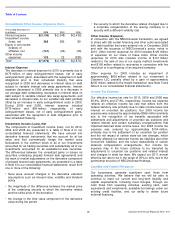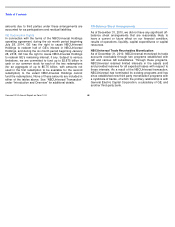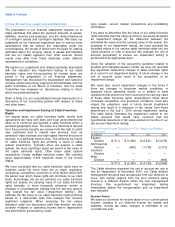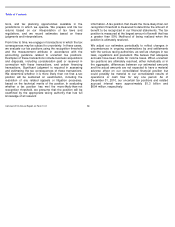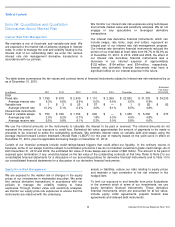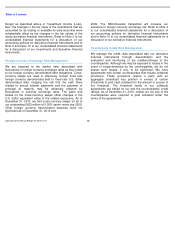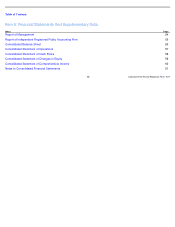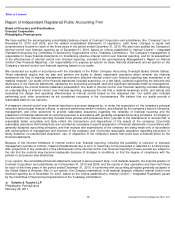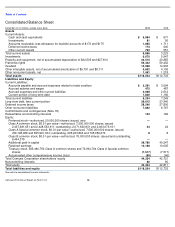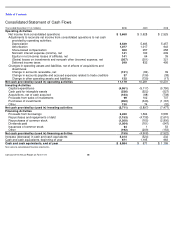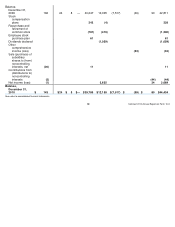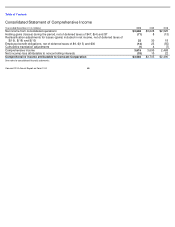Comcast 2010 Annual Report Download - page 58
Download and view the complete annual report
Please find page 58 of the 2010 Comcast annual report below. You can navigate through the pages in the report by either clicking on the pages listed below, or by using the keyword search tool below to find specific information within the annual report.
Table of Contents
The table below summarizes the fair values and contract terms of financial instruments subject to interest rate risk maintained by us
as of December 31, 2010.
We use the notional amounts on the instruments to calculate the interest to be paid or received. The notional amounts do not
represent the amount of our exposure to credit loss. Estimated fair value approximates the amount of payments to be made or
proceeds to be received to settle the outstanding contracts. We estimate interest rates on variable debt and swaps using the
average implied forward London Interbank Offered Rate (“LIBOR”)
for the year of maturity based on the yield curve in effect on
December 31, 2010, plus the applicable borrowing margin on December 31, 2010.
Certain of our financial contracts include credit-ratings-
based triggers that could affect our liquidity. In the ordinary course of
business, some of our swaps could be subject to termination provisions if we do not maintain investment grade credit ratings. As of
both December 31, 2010 and 2009, the estimated fair value of those swaps was an asset of $26 million. The amount to be paid or
received upon termination, if any, would be based on the fair value of the outstanding contracts at that time. Refer to Note 2 to our
consolidated financial statements for a discussion of our accounting policies for derivative financial instruments and to Note 10 to
our consolidated financial statements for a discussion of our derivative financial instruments.
(in millions)
2011
2012
2013
2014
2015
Thereafter
Total
Estimated
Fair Value
12/31/2010
Debt
Fixed rate
$
1,799
$
818
$
2,435
$
1,110
$
2,369
$
22,802
$
31,333
$
34,230
Average interest rate
6.3
%
9.6
%
8.6
%
5.0
%
6.9
%
6.6
%
6.8
%
Variable rate
$
1
$
3
$
20
$
57
$
—
$
1
$
82
$
82
Average interest rate
10.2
%
5.1
%
6.4
%
4.0
%
8.1
%
8.5
%
4.8
%
Interest rate instruments
Fixed to variable swaps
$
750
$
300
$
1,700
$
900
$
—
$
1,650
$
5,300
$
273
Average pay rate
2.0
%
9.2
%
6.7
%
1.8
%
0.0
%
4.9
%
4.8
%
Average receive rate
5.5
%
9.8
%
8.1
%
5.3
%
0.0
%
5.8
%
6.6
%
51
Comcast 2010 Annual Report on Form 10-
K
Item 7A: Quantitative and Qualitative
Disclosures About Market Risk
Interest Rate Risk Management
We maintain a mix of fixed-rate and variable-rate debt. We
are exposed to the market risk of adverse changes in interest
rates. In order to manage the cost and volatility relating to the
interest cost of our outstanding debt, we enter into various
interest rate risk management derivative transactions in
accordance with our policies.
We monitor our interest rate risk exposures using techniques
that include market value and sensitivity analyses. We do not
engage in any speculative or leveraged derivative
transactions.
Our interest rate derivative financial instruments, which can
include swaps, rate locks, caps and collars, represent an
integral part of our interest rate risk management program.
Our interest rate derivative financial instruments reduced the
portion of our total debt at fixed rates from 99.7% to 82.9% as
of December 31, 2010. In 2010, 2009 and 2008, the effect of
our interest rate derivative financial instruments was a
decrease in our interest expense of approximately
$132 million, $104 million and $34 million, respectively.
Interest rate derivative financial instruments may have a
significant effect on our interest expense in the future.
Equity Price Risk Management
We are exposed to the market risk of changes in the equity
prices of our investments in marketable securities. We enter
into various derivative transactions in accordance with our
policies to manage the volatility relating to these
exposures. Through market value and sensitivity analyses,
we monitor our equity price risk exposures to ensure that the
instruments are matched with the underlying
assets or liabilities, reduce our risks relating to equity prices
and maintain a high correlation to the risk inherent in the
hedged item.
To limit our exposure to and benefits from price fluctuations
in the common stock of some of our investments, we use
equity derivative financial instruments. These derivative
financial instruments, which are accounted for at fair value,
include equity collar agreements, prepaid forward sale
agreements and indexed debt instruments.



